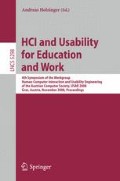Abstract
PowerPoint is one of the most frequently used tools to present multimedia for educational purposes. Nevertheless, little is known about the users’ needs when using PowerPoint during lecturing. Our study focused on the presenter’s needs in this context of use. We interviewed nine university lecturers from the computer science department by means of a questionnaire. The results show that users require features that are not yet realised with PowerPoint. For example, the control and use of other media should be adequately integrated. Or the navigation within the slide collection should be improved to better meet the users’ needs. Based on our findings, we outline required system features and suggest solutions in form of a prototype.
Access this chapter
Tax calculation will be finalised at checkout
Purchases are for personal use only
Preview
Unable to display preview. Download preview PDF.
References
Parker, I.: Absolute PowerPoint: Can a software package edit your thoughts? The New Yorker (2001) (accessed March 6, 2008), http://nbc-links.com/miscellaneous/AbsolutePPT.pdf
Bartsch, R.A., Cobern, K.M.: Effectiveness of PowerPoint presentations in lectures. Computers & Education 41(1), 77–86 (2003)
Susskind, J.E.: Limits of PowerPoint’s Power: Enhancing students’ self-efficacy and attitudes but not their behavior. Computers & Education 50(4), 1228–1239 (2008)
Craig, R., Amernic, J.: PowerPoint Presentation Technology and the Dynamics of Teaching. Innov. High Educ. 31, 147–160 (2006)
Holzinger, A., Kickmeier-Rust, M., Albert, D.: Dynamic Media in Computer Science Education; Content Complexity and Learning Performance: Is Less More? Educational Technology & Society 11(1), 279–290 (2008)
Golub, E.: Handwritten Slides on a TabletPC in a Discrete Mathematics Course. In: Proc. of the 35th SIGCSE Technical Symposium on Computer Science Education, pp. 51–55 (2004)
Anderson, R., Simon, B., Wolfman, S.A., VanDeGrift, T., Yasuhara, K.: Experiences with a tablet PC based lecture presentation system in computer science courses. In: Proc. of the 35th SIGCSE Technical Symposium on Computer Science Education, pp. 56–60 (2004)
Anderson, R.J., Hoyer, C., Wolfman, S.A., Anderson, R.: A study of digital ink in lecture presentation. In: Proc. of the SIGCHI Conference on Human Factors in Computing Systems, Vienna, Austria, pp. 567–574 (2004)
Tufte, E.: The Cognitive Style of Power Point. Graphics Press (2003)
Holman, D., et al.: Fly: An Organic Presentation Tool. In: Work in Progress Contribution to CHI 2006, pp. 863–868 (2006)
Good, L., Bederson, B.: Zoomable User Interfaces as a Medium for Slide Show Presentations. Information Visualization 1(1), 35–49 (2002)
Norrie, M.C., Signer, B., Weibel, N.: General Framework for the Rapid Development of Interactive Paper Applications. In: CoPADD 2006, 1st International Workshop on Collaborating over Paper and Digital Documents, Banff, Canada, pp. 9–12 (November 2006)
Signer, B.: Fundamental Concepts for Interactive Paper and Cross-Media Information Spaces. PhD thesis, ETH Zurich, Dissertation ETH No. 16218 (May 2006)
Anoto, A.B.: http://www.anoto.com
Signer, B., Norrie, M.C.: PaperPoint: A Paper-Based Presentation and Interactive Paper Prototyping Tool. In: Proceedings of TEI 2007, First International Conference on Tangible and Embedded Interaction, Baton Rouge, USA, pp. 57–64 (February 2007)
Nielsen, J.: Usability Engineering. Academic Press, Chestnut Hill (1993)
Holtzblatt, K., Burns Wendell, J., Wood, S.: Rapid Contextual Design. A How-To Guide to Key Techniques for User-Centered Design. Morgan Kaufmann, San Francisco (2005)
Birnholtz, J.: Back to School: Design Principles for Improving Webcast Interactivity From Face-to-Face Classroom Observation, DIS, 311–319 (2006)
Liu, Q., Kimber, D., Zhao, F., Huang, J.: Framework for effective use of multiple displays. In: Proceedings of SPIE Int. Symposium ITCom on Multimedia Systems and Applications VIII (2005)
Author information
Authors and Affiliations
Editor information
Editors and Affiliations
Rights and permissions
Copyright information
© 2008 Springer-Verlag Berlin Heidelberg
About this paper
Cite this paper
Reuss, E.I., Signer, B., Norrie, M.C. (2008). PowerPoint Multimedia Presentations in Computer Science Education: What Do Users Need?. In: Holzinger, A. (eds) HCI and Usability for Education and Work. USAB 2008. Lecture Notes in Computer Science, vol 5298. Springer, Berlin, Heidelberg. https://doi.org/10.1007/978-3-540-89350-9_20
Download citation
DOI: https://doi.org/10.1007/978-3-540-89350-9_20
Publisher Name: Springer, Berlin, Heidelberg
Print ISBN: 978-3-540-89349-3
Online ISBN: 978-3-540-89350-9
eBook Packages: Computer ScienceComputer Science (R0)

